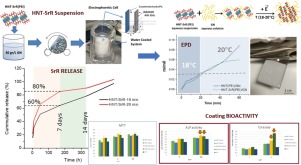当前位置:
X-MOL 学术
›
Colloids Surf. B Biointerfaces
›
论文详情
Our official English website, www.x-mol.net, welcomes your feedback! (Note: you will need to create a separate account there.)
Effect of SrR delivery in the biomarkers of bone regeneration during the in vitro degradation of HNT/GN coatings prepared by EPD.
Colloids and Surfaces B: Biointerfaces ( IF 5.8 ) Pub Date : 2020-03-04 , DOI: 10.1016/j.colsurfb.2020.110944 Seyyed Behnam Abdollahi Boraei 1 , Jhamak Nourmohammadi 2 , Fatemeh Sadat Mahdavi 3 , Joaquin Yus 4 , A Ferrandez-Montero 4 , Antonio Javier Sanchez-Herencia 4 , Zoilo Gonzalez 4 , Begona Ferrari 4
Colloids and Surfaces B: Biointerfaces ( IF 5.8 ) Pub Date : 2020-03-04 , DOI: 10.1016/j.colsurfb.2020.110944 Seyyed Behnam Abdollahi Boraei 1 , Jhamak Nourmohammadi 2 , Fatemeh Sadat Mahdavi 3 , Joaquin Yus 4 , A Ferrandez-Montero 4 , Antonio Javier Sanchez-Herencia 4 , Zoilo Gonzalez 4 , Begona Ferrari 4
Affiliation

|
Among strontium-based drugs, the Strontium ranelate (SrR) is a divalent strontium salt of ranelic acid which has an overall effect over the bone microarchitecture improvement. However, some findings reveal that the SrR affects in an opposite manner to the cell proliferation and osteoblastic differentiation, based on its concentration. Consequently, its release should be controlled. The incorporation of Halloysite nanotubes (HNT) as nanocarriers of SrR, into gelatine (GN) coatings, tailors the release of this anabolic bone-forming and anti-catabolic agent to stimulate bone growth. In fact, as-prepared GN/HNT-SrR coatings release 100 % SrR in phosphate buffered saline (PBS) within 21 days, and cellular studies of the nanocomposite coatings (MTT, Alkaline Phosphatase activity (ALP) and Calcium deposition assay) confirm the valuable bio-performance of these composite coatings to enhanced bone regeneration. In the present manuscript, suspensions with HNT/GN weight ratio of 0.5 are formulated to coat AISI 316 L stainless steel foils by Electrophoretic Deposition (EPD). Zeta potential determination is used to stablish the drug loading (HNT-SrR) by electrostatic interaction, as well as to optimize the dispersion of bare HNT and HNT SrR-loaded in a GN aqueous solution. Polyethilenimnine (PEI) is used as stabilizer to buffer the suspension media, assure cargo-drug dispersion and sequential release, while the thermal gelling of the suspension controls and step up the coating formation during EPD.
中文翻译:

EPD制备的HNT / GN涂层体外降解过程中SrR传递对骨骼再生生物标志物的影响。
在基于锶的药物中,雷奈酸锶(SrR)是雷尼酸的二价锶盐,对骨骼微结构的改善具有总体作用。然而,一些发现表明,基于其浓度,SrR以与细胞增殖和成骨细胞分化相反的方式起作用。因此,应控制其释放。将作为SrR纳米载体的埃洛石纳米管(HNT)掺入明胶(GN)涂层中,可调节这种合成代谢骨形成和抗分解代谢剂的释放,以刺激骨骼生长。实际上,制备后的GN / HNT-SrR涂层会在21天内在磷酸盐缓冲盐水(PBS)中释放100%SrR,并对纳米复合涂层(MTT,碱性磷酸酶活性(ALP)和钙沉积测定)证实了这些复合涂层对于增强骨骼再生具有有价值的生物性能。在本手稿中,配制HNT / GN重量比为0.5的悬浮液,以通过电泳沉积(EPD)涂覆AISI 316 L不锈钢箔。Zeta电势测定用于通过静电相互作用稳定药物负载(HNT-SrR),以及优化GN水溶液中裸露的HNT和HNT SrR的分散度。聚乙烯乙胺(PEI)用作稳定剂,以缓冲悬浮介质,确保货物-药物分散和顺序释放,而悬浮液的热胶凝则控制着EPD期间涂层的形成。将HNT / GN重量比为0.5的悬浮液配制为通过电泳沉积(EPD)涂覆AISI 316 L不锈钢箔。Zeta电势测定用于通过静电相互作用稳定药物负载(HNT-SrR),以及优化GN水溶液中裸露的HNT和HNT SrR的分散度。聚乙烯乙胺(PEI)用作稳定剂,以缓冲悬浮介质,确保货物-药物分散和顺序释放,而悬浮液的热胶凝则控制着EPD期间涂层的形成。将HNT / GN重量比为0.5的悬浮液配制为通过电泳沉积(EPD)涂覆AISI 316 L不锈钢箔。Zeta电势测定用于通过静电相互作用稳定药物负载(HNT-SrR),以及优化GN水溶液中裸露的HNT和HNT SrR的分散度。聚乙烯乙胺(PEI)用作稳定剂,以缓冲悬浮介质,确保货物-药物分散和顺序释放,而悬浮液的热胶凝则控制着EPD期间涂层的形成。以及优化GN水溶液中裸露的HNT和HNT SrR的分散。聚乙烯乙胺(PEI)用作稳定剂,以缓冲悬浮介质,确保货物-药物分散和顺序释放,而悬浮液的热胶凝则控制着EPD期间涂层的形成。以及优化GN水溶液中裸露的HNT和HNT SrR的分散。聚乙烯乙胺(PEI)用作稳定剂,以缓冲悬浮介质,确保货物-药物分散和顺序释放,而悬浮液的热胶凝则控制着EPD期间涂层的形成。
更新日期:2020-03-04
中文翻译:

EPD制备的HNT / GN涂层体外降解过程中SrR传递对骨骼再生生物标志物的影响。
在基于锶的药物中,雷奈酸锶(SrR)是雷尼酸的二价锶盐,对骨骼微结构的改善具有总体作用。然而,一些发现表明,基于其浓度,SrR以与细胞增殖和成骨细胞分化相反的方式起作用。因此,应控制其释放。将作为SrR纳米载体的埃洛石纳米管(HNT)掺入明胶(GN)涂层中,可调节这种合成代谢骨形成和抗分解代谢剂的释放,以刺激骨骼生长。实际上,制备后的GN / HNT-SrR涂层会在21天内在磷酸盐缓冲盐水(PBS)中释放100%SrR,并对纳米复合涂层(MTT,碱性磷酸酶活性(ALP)和钙沉积测定)证实了这些复合涂层对于增强骨骼再生具有有价值的生物性能。在本手稿中,配制HNT / GN重量比为0.5的悬浮液,以通过电泳沉积(EPD)涂覆AISI 316 L不锈钢箔。Zeta电势测定用于通过静电相互作用稳定药物负载(HNT-SrR),以及优化GN水溶液中裸露的HNT和HNT SrR的分散度。聚乙烯乙胺(PEI)用作稳定剂,以缓冲悬浮介质,确保货物-药物分散和顺序释放,而悬浮液的热胶凝则控制着EPD期间涂层的形成。将HNT / GN重量比为0.5的悬浮液配制为通过电泳沉积(EPD)涂覆AISI 316 L不锈钢箔。Zeta电势测定用于通过静电相互作用稳定药物负载(HNT-SrR),以及优化GN水溶液中裸露的HNT和HNT SrR的分散度。聚乙烯乙胺(PEI)用作稳定剂,以缓冲悬浮介质,确保货物-药物分散和顺序释放,而悬浮液的热胶凝则控制着EPD期间涂层的形成。将HNT / GN重量比为0.5的悬浮液配制为通过电泳沉积(EPD)涂覆AISI 316 L不锈钢箔。Zeta电势测定用于通过静电相互作用稳定药物负载(HNT-SrR),以及优化GN水溶液中裸露的HNT和HNT SrR的分散度。聚乙烯乙胺(PEI)用作稳定剂,以缓冲悬浮介质,确保货物-药物分散和顺序释放,而悬浮液的热胶凝则控制着EPD期间涂层的形成。以及优化GN水溶液中裸露的HNT和HNT SrR的分散。聚乙烯乙胺(PEI)用作稳定剂,以缓冲悬浮介质,确保货物-药物分散和顺序释放,而悬浮液的热胶凝则控制着EPD期间涂层的形成。以及优化GN水溶液中裸露的HNT和HNT SrR的分散。聚乙烯乙胺(PEI)用作稳定剂,以缓冲悬浮介质,确保货物-药物分散和顺序释放,而悬浮液的热胶凝则控制着EPD期间涂层的形成。

























 京公网安备 11010802027423号
京公网安备 11010802027423号